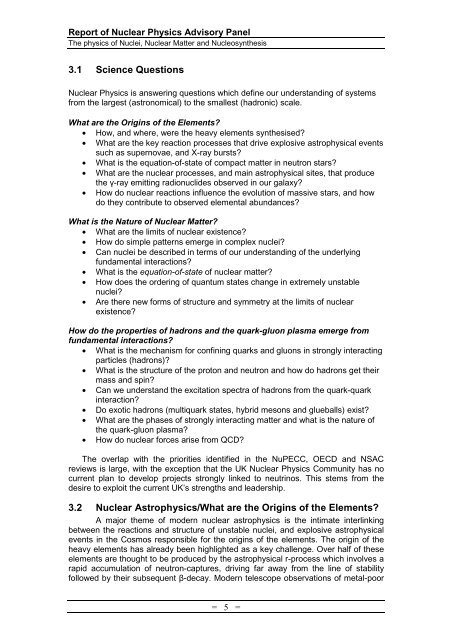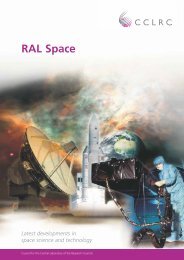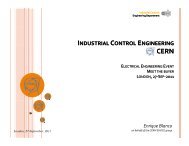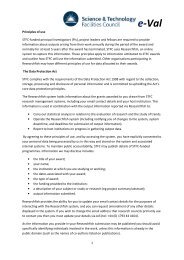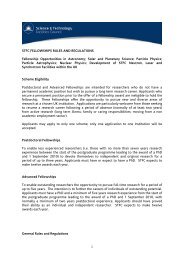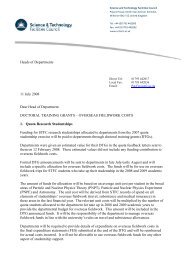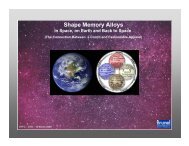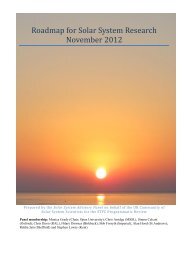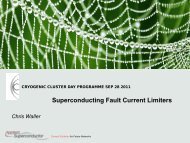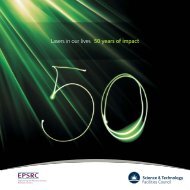Nuclear Physics Advisory Panel (NPAP) report (PDF-3.8 MB) - STFC
Nuclear Physics Advisory Panel (NPAP) report (PDF-3.8 MB) - STFC
Nuclear Physics Advisory Panel (NPAP) report (PDF-3.8 MB) - STFC
Create successful ePaper yourself
Turn your PDF publications into a flip-book with our unique Google optimized e-Paper software.
Report of <strong>Nuclear</strong> <strong>Physics</strong> <strong>Advisory</strong> <strong>Panel</strong><br />
The physics of Nuclei, <strong>Nuclear</strong> Matter and Nucleosynthesis<br />
3.1 Science Questions<br />
<strong>Nuclear</strong> <strong>Physics</strong> is answering questions which define our understanding of systems<br />
from the largest (astronomical) to the smallest (hadronic) scale.<br />
What are the Origins of the Elements?<br />
• How, and where, were the heavy elements synthesised?<br />
• What are the key reaction processes that drive explosive astrophysical events<br />
such as supernovae, and X-ray bursts?<br />
• What is the equation-of-state of compact matter in neutron stars?<br />
• What are the nuclear processes, and main astrophysical sites, that produce<br />
the γ-ray emitting radionuclides observed in our galaxy?<br />
• How do nuclear reactions influence the evolution of massive stars, and how<br />
do they contribute to observed elemental abundances?<br />
What is the Nature of <strong>Nuclear</strong> Matter?<br />
• What are the limits of nuclear existence?<br />
• How do simple patterns emerge in complex nuclei?<br />
• Can nuclei be described in terms of our understanding of the underlying<br />
fundamental interactions?<br />
• What is the equation-of-state of nuclear matter?<br />
• How does the ordering of quantum states change in extremely unstable<br />
nuclei?<br />
• Are there new forms of structure and symmetry at the limits of nuclear<br />
existence?<br />
How do the properties of hadrons and the quark-gluon plasma emerge from<br />
fundamental interactions?<br />
• What is the mechanism for confining quarks and gluons in strongly interacting<br />
particles (hadrons)?<br />
• What is the structure of the proton and neutron and how do hadrons get their<br />
mass and spin?<br />
• Can we understand the excitation spectra of hadrons from the quark-quark<br />
interaction?<br />
• Do exotic hadrons (multiquark states, hybrid mesons and glueballs) exist?<br />
• What are the phases of strongly interacting matter and what is the nature of<br />
the quark-gluon plasma?<br />
• How do nuclear forces arise from QCD?<br />
The overlap with the priorities identified in the NuPECC, OECD and NSAC<br />
reviews is large, with the exception that the UK <strong>Nuclear</strong> <strong>Physics</strong> Community has no<br />
current plan to develop projects strongly linked to neutrinos. This stems from the<br />
desire to exploit the current UK’s strengths and leadership.<br />
3.2 <strong>Nuclear</strong> Astrophysics/What are the Origins of the Elements?<br />
A major theme of modern nuclear astrophysics is the intimate interlinking<br />
between the reactions and structure of unstable nuclei, and explosive astrophysical<br />
events in the Cosmos responsible for the origins of the elements. The origin of the<br />
heavy elements has already been highlighted as a key challenge. Over half of these<br />
elements are thought to be produced by the astrophysical r-process which involves a<br />
rapid accumulation of neutron-captures, driving far away from the line of stability<br />
followed by their subsequent β-decay. Modern telescope observations of metal-poor<br />
= 5 =


